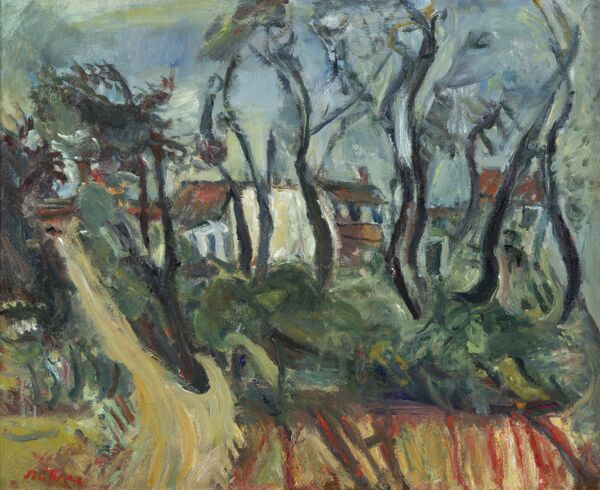Chaim Soutine
(1893-1943)
Soutine was born in Russia near Minsk, Belarus and was the tenth of eleven children. He studied in Vilnius at the Vina Academy of Fine Arts from 1910-1913, before emigrating to Paris where he studied at the Ecole des Beaux-Arts under Fernand Cormon.
During his years as a young painter Soutine would often visit the town of Ceret in the Pyrennes mountains, where he painted wild and apocalyptic landscapes. In Paris he preferred to paint portraits of figures such as valets and maids revealing a more expressive style. lived at La Ruche, a residence for struggling artists in Montparnasse and became good friends with Amedeo Modigliani. Modigliani painted his portrait a number of times, most famously on the apartment door belonging to their art dealer Leopold Zborowski. It was under the protection of Zborowski that Soutine escaped from the German bombing of Paris to Nice in World War I.
During his years as a young painter from 1919-1822, he visited the town of Ceret in the Pyrennes mountains. While living here Soutine started painting landscapes with wild apocalyptic themes. In Paris he began painting portraits of figures, his favorite being valets and maids, with a more expressive style. He socialized with great painters such as Marc Chagall, Jules Pascin, and Amedeo Mogdialiani.
Once the war was over Soutine’s work caught the eye of a highly influential art dealer named Paul Guillaume. The American collector Albert C. Barnes also took a great interest in Soutine’s art, buying 60 of his paintings in one go. It was his carcass paintings, inspired by Rembrandt’s still life on the same subject, that have since become some of his most iconic works. In February 2006, ‘Le Boeuf Ecorche’ from this series, originally estimated to reach £4.8million, sold for a record of £7.8million to an anonymous buyer at Christie’s London.
The majority of Soutine’s work was produced between the periods of 1920 to 1929. From 1930 to 1935 Madeleine Castaing and her husband became his patrons, and Soutine held his first exhibition in Chicago in 1935. While Soutine seldom exhibited he did take part in The Origins and Development of International Independent Art, an important exhibition held at the Galerie Nationale du Jeu de Paume, Paris, in 1937. This exhibition saw Soutine hailed as a great painter. Not long after this exhibition France was once again invaded by German troops at the outbreak of World War Two. As a Jew, Soutine had to escape the capital once more and go into hiding from the German Gestapo. It was while in hiding that Soutine developed a stomach ulcer and had to return to Paris for emergency surgery in an attempt to save his life. Unfortunately the surgery failed and Soutine died of a perforated ulcer on the 9th August, 1943.
An expressionist painter constantly dissatisfied with his talent, Chaim Soutine portrayed his own violent emotions in his work using vivid colors and distorted images. His artistic style mixed his Jewish heritage with Fauvism and Cubism.

